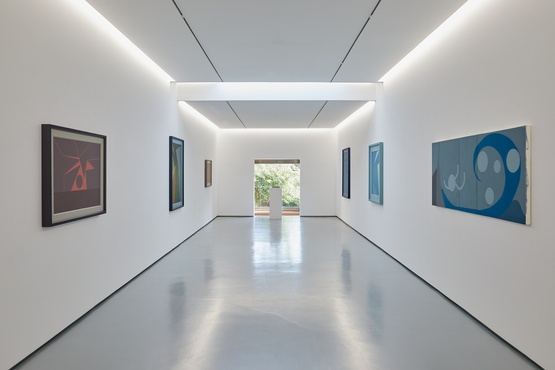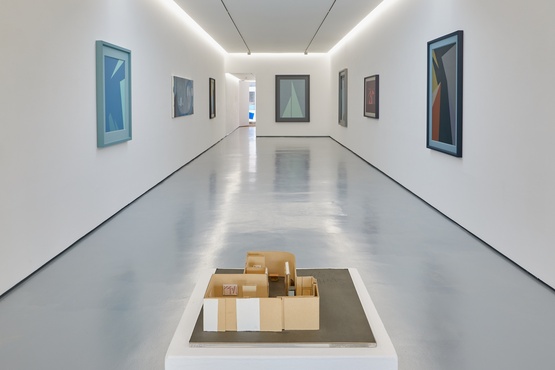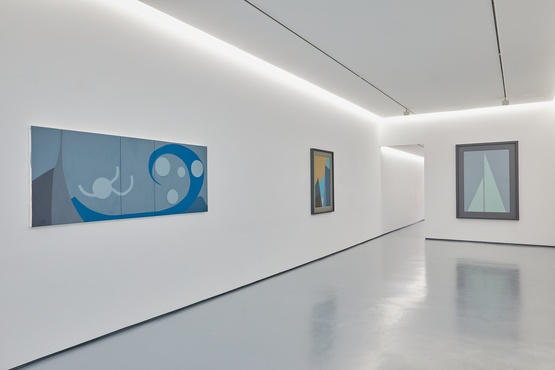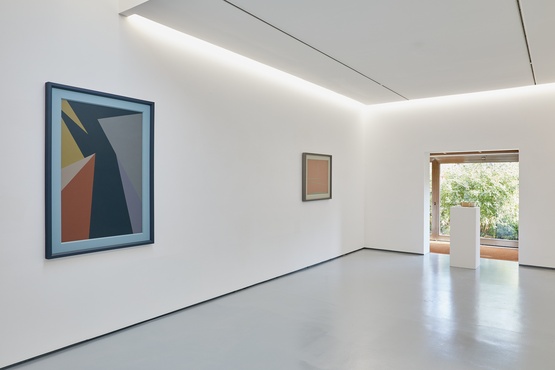Fernando Lanhas
Quanto tempo o Tempo tem
A collection of oils, drawings,
collages, painted stones and (so-called) written words come together in the
unified space of an exhibition and a book to tell us how Lanhas understood the
world. The exhibition, and this book that extends it, are neither a
retrospective nor an anthological summary of the work (and life) of Fernando
Lanhas. And yet, thanks to the sufficient information they provide, they give
us access to the essentials of his work and creative life. The various fields
of scientific study that he cultivated, beginning between 1940 (palaeontology
and geology) and 1952 (astronomy), but also botany and even archaeology, were
always combined with artistic knowledge, placing him in direct descent from the
global spirit of Renaissance Man.
Lanhas' work makes us aware of
realities that we can hardly apprehend with our senses. In this text, we will
try to demonstrate that his work exists (and wants to be understood) in humanly
unmeasurable dimensions of Space and Time - as if the realities that Lanhas
created (paintings, drawings, words, ...), and the realities for which they
were created, were not measurable. ), and the realities he has looked at and
worked on most enthusiastically (stars and planets, rocks and fossils), exist
simultaneously, have always been where they are and will continue to be there
after the exhibitions are over, after the books are closed, after the words
have changed their meaning, after those who have spoken about it all, those who
have seen it all, have disappeared, after the stars have moved away modelling
new universes... In short, everything in Lanhas' conceptual and creative
process challenges the short time and scarce space we are forced to live in and
confronts us with successive Infinities.
When we get to know the work and
life of Lanhas (whom his friend, critic and biographer Fernando Guedes
symbolically called ‘Seven Faces’) in depth, we will realise that it was his
insatiable desire to know the world that led him down these seven (or more)
paths. The man we are interested in revealed himself entirely in his practice
as a plastic artist; but the truth is that he was only a man of the Arts (and
of Letters, as his poems and the narratives of his dreams are of decisive
complementary interest) to the extent that he also understood himself as a man
of Science. And it was to the extent that he crossed the experimental and
objective methodology of science with the subjective experimentalism of art
that we also find him as a man of faith. Lanhas accepted, in parallel,
scientific rationality and the dimension of the inexplicable, of a knowledge
that is neither subject to proof nor to the practice of experience, a truth
situated above human laws, and he was willing to use art as a testing ground
for this reality and this mystery.
Being an architect was not, for
Lanhas, a profession that provided him with the stability of a status or
guaranteed a captive place in society; it was an inner vocation that extended
beyond the specific work of building houses or public buildings. He was an
architect because he felt that engineering lacked the dimension of
understanding beauty that would transform him from a mere designer of habitable
spaces into a thinker about the Universe we inhabit. And he was an architect
because visual artists lacked the dimension of understanding the Useful and the
Good that could transform a mere decorator of spaces into a discoverer of the
materials, lines and colours, shapes and spaces that are hidden under the
appearance of the ephemeral and the mere sensory experience.
In the early 1940s, Fernando
Lanhas was an architecture student in Porto and the school (under the direction
of Carlos Ramos) was experiencing moments of high quality teaching and creative
freedom. Art students and architecture students lived together intensely and
what resulted from this conviviality guaranteed the country decades of good
construction, good urbanism and good art. Lanhas was one of the most active
promoters of this youthful energy, organising the various editions of the
Exposições Independentes (with extensions to Lisbon and Coimbra) where, without
the aesthetic barriers of other initiatives, moderns (as defined by the
SPN/SNI), neo-realists and surrealists coexisted for some time and where
abstracts were revealed.
It is precisely as a geo-metric
abstract artist that we should understand the decisive contribution that Lanhas
made to the development of Portuguese art in the 1940s and onwards. His first
paintings were figurative, very expressive both in their material reality and
in their formal exasperation (sometimes made up of sharp angles or continuous
curved lines intersecting on the plane to form schematic figures) and in their
subject matter (faces tortured by old age, for example); but they were already
very refined works in terms of shapes, colours (often shades of the same
colour) and with the perspective almost absent - they were very graphic
paintings. The poetic background that determined and managed these works was
evidently symbolist and expressionist, not in the radical dimension of North
European ex-impressionism, but in the continuity of a post-romantic sensibility
that, in the cultural context (literary and artistic in the north of Portugal)
was rooted in António Carneiro and Teixeira de Pascoaes.
With no specific theoretical
knowledge and little iconographic knowledge of the world's first abstraction
(from the 1920s-30s) or zero knowledge of contemporary abstraction, it was by
intuition that Lanhas (also practically isolated internally) made his move.
Portuguese society's special situation of neutrality and peace, albeit in a
culturally peripheral, uninformed and repressive context, allowed him to
advance along the path of Abstraction before the post-war international
situation had really opened up Europe to the resurgence of this current.
Although it didn't serve as an aesthetic, ethical or political justification
for the quality and success of his work, it is true that Abstraction had the
‘advantage’ over Neo-Realism or Surrealism in that it didn't refer to the realities
of the outside world, thus facilitating the tolerance of the regime and the
more conservative critics towards the works of this current - some of the best
pages on his work come from critics in this area, such as Fernando Guedes or
Selles Paes de Villas-Boas.
His first abstract paintings
began as simplifications of forms from the outside world. The year 1943 to 1944
was, in Lanhas' work, a time of decisive transition, when he carried out his
first truly abstract experiments based on small notes fixed in the margins of
the programmes of some musical auditions. This process resulted in a larger
work, O2-44 (oil number 2 from 1944). The painting was significantly titled
‘The Violin’, before the author had found an objective designation formula for
his works (indicating the technique with a letter, the order number and the
date of realisation).
Nadir Afonso, another Portuguese
pioneer of abstraction, who travelled to Paris in the 1950s, would soon relate
to the international abstract currents in his practices and theorisations (such
as those disseminated by the enlarged Salon des Réalités Nouvelles and the
Denise Renée Gallery); but Lanhas, following a line that avoided Max Bill's
concretism in the same way that he avoided Vasarely's Op dynamism, preferred to
explore lines of metaphysical interpretation.
His paintings developed from
abstract models, determined by the ever-increasing range of information he
gathered in his scientific studies. In his varied plastic work, Lanhas can move
us from the macro (telescopic) image to a micro (microscopic) image; he swings
us between the metaphorical weight of the painted stones and the lightness of a
drawing where a child can lift the world in his hands, like someone throwing a
ball; He takes us from grey colours (where he even mixes rock dust) to sky
blues and violets or from sidereal blacks to the brown of fertile lands; he
makes us move (in a process that is always reversible) between the dynamic
circular and diagonal lines and the uniform fields of the background colours.
Lanhas thus creates different planes and levels of spatiality, going beyond the
limitations of the dominant two-dimensionality and opening up the
interpretation of each work to different senses and visual realities.
With these elements Lanhas built
a vocabulary of open signs where the circle or circumference, its fragments and
segments, triangular areas or bundles of straight lines, are associated in
games of instability and multiple balance. They are forms that can be
infinitely associated and extended in space, simulating schematic records of
landscapes, signs centred in space, constructing the fiction of complex graphic
signs belonging to an unknown communication code, a secret writing that
requires deciphering...
The basic composition of his
works is made up of the usual segmentation of the square and the circle, the
intersection of the resulting geometric shapes and the lines between them.
However, the final image of the work presents itself as a fragment of a unity
that we will have to try to reconstitute, as an enigma that we will have to
solve. Obliterating the paths of his reasoning, obliterating the lines of
construction of each work, as if the coordinates were removed from a map or
parts of the reasoning were removed from the demonstration of a theorem, Lanhas
wanted to express himself in riddles, like a prophet.
This whole process of
understanding and interpreting the world we've been trying to describe forced
Fernando Lanhas into an unequal confrontation with Time and its extension, its
materials, forms and places. But the artist didn't give in or renounce his free
will as a creator: his Stones always seemed to meet the shapes he inscribed on
them and not the other way round; his paintings, by extending their conception
and realisation time, sometimes by several decades (by returning to formal and
colour solutions, associating distant dates in time), simulated extending time
within Time; finally, his dreams revealed his attempt to control his own body
within the Space-Time binomial.
With no clear external references
and no internal antecedents (Amadeo's work, which in those years was very
poorly known, could not in any case provide any clues of interest to him)
Lanhas didn't create any disciples either - in this he coincides with the
common individual careers of the great modern Portuguese artists, around whom
it has always proved impossible to form ‘schools’, in a dizzying array of
heteronyms incapable of creating aesthetically coherent and lasting movements.
What Lanhas can pass on to the
future lies outside his creative sphere: for example, his ethical attitude and
restless wonder at the passage of time, the way this led him from artistic
creation to civic pedagogy (researching and publishing, designing museums and
libraries...), the attempt to prolong the ephemerality of life and human works
through an art conceived in harmony with the eternity of the natural elements
that surround us.
The exhibition and the book that serves it reflect Lanhas' understanding of the flow of elements that we have listed. In his artistic work, there is a set of statements with a metaphysical dimension that he wished could accompany scientific laws. Lanhas' creative poetics exist in this balance between human Truth and Mystery.
João Pinharanda
Malaucène, 3 de Agosto de 2024












